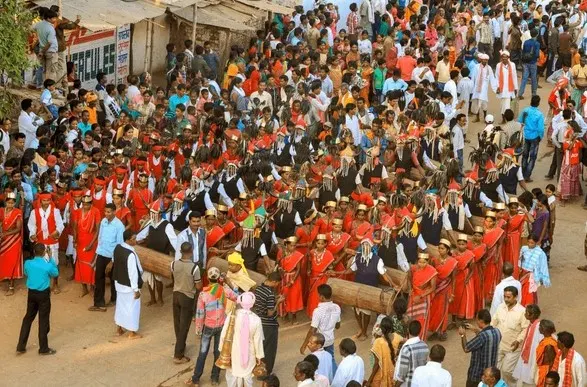Bastar Dussehra
Bastar Dussehra is a unique and prolonged festival celebrated in the Bastar district of Chhattisgarh, India. Unlike the conventional Dussehra festival, which usually lasts for a day or two, Bastar Dussehra extends over 75 days. It is characterized by elaborate rituals, vibrant cultural performances, and the worship of local deities.
https://bharatpractice.blogspot.com/2024/04/how-many-parts-in-indian-constitution.html
 |
| Bastar Dussehra |
The festival begins with the invocation of Goddess Danteshwari, the presiding deity of Bastar, and the distribution of sacred water known as "Tirth." Throughout the 75 days, various rituals are performed, including the traditional "Pata Jatra," during which the divine palanquin of the goddess is carried to different villages for worship.
A key feature of Bastar Dussehra is the ceremonial procession of chariots, called "Rath Yatra," in which the idols of local deities are paraded through the streets in ornately decorated chariots. This procession is accompanied by chanting, singing, and the beating of traditional drums.
The festival also includes cultural programs, folk dances, tribal music performances, and traditional sports competitions, showcasing the rich cultural heritage of the tribal communities in Chhattisgarh.
Bastar Dussehra is not only a religious festival but also a celebration of community unity and cultural diversity. It brings together people from different tribes and communities, fostering harmony and a sense of belonging among them. The festival concludes with the immersion of the idols in local water bodies, symbolizing the departure of the deities after blessing the devotees with prosperity and happiness.
https://bharatpractice.blogspot.com/2024/04/who-defeated-mughal-empire.html
History of Bastar Dussehra
Bastar Dussehra has a rich historical significance deeply rooted in the tribal culture of the Bastar region in Chhattisgarh, India. The festival is believed to have originated several centuries ago and is associated with various legends and historical events.
One popular legend states that Bastar Dussehra was initiated by the Kakatiya rulers of Warangal in present-day Telangana, who introduced the festival to commemorate their victory over the Chalukyas. Over time, the festival evolved and became an integral part of the cultural fabric of the Bastar region.
Another historical aspect of Bastar Dussehra is its association with the local deity Maoli Devi, who is revered as the presiding goddess of the Bastar dynasty. According to folklore, the rulers of Bastar sought the blessings of Maoli Devi for prosperity and protection, and the festival of Dussehra became an occasion to honor her divine presence.
Additionally, Bastar Dussehra is closely linked to the worship of Danteshwari Devi, the principal deity of the region, whose temple in Dantewada attracts devotees from far and wide during the festival. The rituals and ceremonies associated with Bastar Dussehra reflect the deep-seated religious beliefs, cultural heritage, and tribal traditions of the indigenous communities inhabiting the Bastar region.
Overall, the history of Bastar Dussehra is characterized by a blend of mythological narratives, historical events, and indigenous customs, making it a significant and cherished festival in the cultural landscape of Chhattisgarh.
https://bharatpractice.blogspot.com/2024/03/why-bharat-matters.html
Why is Bastar Dussehra celebrated?
Bastar Dussehra is celebrated to honor and worship Goddess Danteshwari, the presiding deity of Bastar district in Chhattisgarh, India. It is believed that the festival commemorates the victory of Goddess Danteshwari over the demon Mahishasura, symbolizing the triumph of good over evil.
Additionally, Bastar Dussehra is celebrated as a way to express gratitude to the local deities for their blessings and protection. It is also a time for the community to come together, renew social bonds, and celebrate their cultural heritage through rituals, music, dance, and other traditional festivities.
The festival holds immense significance for the tribal communities of Bastar, as it not only reaffirms their faith in their deities but also serves as a reminder of their shared identity and values. Overall, Bastar Dussehra is celebrated with great enthusiasm and reverence, highlighting the spiritual, cultural, and social significance of the event for the people of Bastar.
https://bharatpractice.blogspot.com/2024/04/british-raj.html
The Myth of Bastar Dussehra
The myth of Bastar Dussehra revolves around the victory of Goddess Danteshwari over the demon Mahishasura. According to local folklore, Mahishasura, a powerful demon, terrorized the region of Bastar, causing immense suffering and chaos among the people. In their desperation, the residents sought the help of the gods and goddesses, entreating them to rid the land of the demon's tyranny.
In response to their prayers, Goddess Danteshwari, an incarnation of Goddess Durga, emerged to confront Mahishasura. A fierce battle ensued between the goddess and the demon, lasting for several days. Despite Mahishasura's formidable powers, Goddess Danteshwari ultimately emerged victorious, slaying the demon and liberating the people of Bastar from his oppression.
In commemoration of this divine triumph, the festival of Bastar Dussehra is celebrated annually with great fervor and devotion. It serves as a reminder of the victory of good over evil and the power of the divine to protect and preserve righteousness in the world.
https://bharatpractice.blogspot.com/2024/04/the-gaur-is-state-animal-of-which-of.html
What Makes It Unique
Bastar Dussehra stands out due to several unique aspects:
Tribal Tradition: Unlike traditional Dussehra celebrations, Bastar Dussehra is rooted in tribal culture and traditions, reflecting the distinct heritage of the Bastar region in Chhattisgarh.
Duration: Bastar Dussehra spans over 75 days, making it one of the longest festivals in India. It begins on the day of Dussehra and continues until the festival of Diwali.
Rituals and Ceremonies: The festival involves a series of elaborate rituals, ceremonies, and cultural performances conducted by various tribal communities, showcasing their vibrant customs and practices.
Devotion to Local Deities: Bastar Dussehra is centered around the worship of local deities such as Maoli Devi and Danteshwari Devi, highlighting the region's deep-rooted spiritual beliefs and reverence for nature.
Unique Celebrations: The festival features distinctive rituals such as the ceremonial cutting of 75 bamboo poles (symbolizing the 75-day duration), traditional dance performances, and the grand procession of deities atop chariots.
Community Participation: Bastar Dussehra brings together people from different tribal communities, fostering a sense of unity, solidarity, and cultural pride among the residents of Bastar.
Frequently Ask Questions
- What is the significance of Bastar Dussehra?
No comments:
Post a Comment